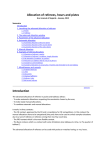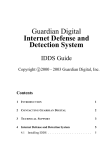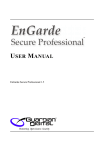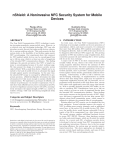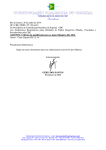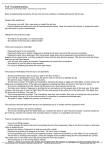Download AdvancedAllocationMa.. - engarde
Transcript
Allocation of referees, hours and pistes
User manual of Engarde - November, 2011
Summary
Introduction
1. Launching the advanced allocation of referees
1.1. Poules
1.2. Tableaux
2. The advanced allocation window
3. Parameters of the advanced allocation
4. Automatic allocation
4.1. Automatic allocation of the first referee
4.2. Automatic allocation of the second referee
4.3. Automatic allocation of the video referee
5. Manual allocation
6. Examples of referee allocations
6.1. Allocation of referees in poules
6.2. Allocation of referees in a tableau, simple allocation
6.3. FIE allocation of a tableau "by quarter"
6.4. Allocation of a tableau that has not yet its fencers
6.5. Example on several tableaux
6.6. Example of allocation on consecutive 2 matches and of transfer to the next tableau
7. Miscellaneous
7.1. Keyboard shortcuts
7.2. Undo
7.3. Documents
7.4. Displayed affiliation
7.5. Referees' order
Summary
Introduction
The advanced allocation of referees in poules and tableaux allows:
- To make automatic allocations respecting the constraints chosen by the user,
- To make easily manual allocations,
- To combine automatic and manual allocations.
It works in three contexts:
- The FIE context, approved by the FIE and is mandatory for FIE competitions. In this context, the manual
allocations have to be exceptional (they only have to be used to unlock complex situations due to a lack of
referees or referees coming from too few countries),
- The PRO context which is the more flexible context.
- The Basic context, which is a context with some limitations (one tableau at a time, no "by quarter of tableau").
The advanced allocation of referees can be used with poules or matches having, or not, hours.
It can be used on a tableau which does not yet have fencers if it follows a tableau having fencers. In this case, all
the possible progressions of fencers are taken into account for the allocation of referees (which can make the
operation more difficult).
Poules and matches may have 3 match referees and one video referee. Video referees can be used only in the
PRO and FIE contexts.
1
Summary
1. Launching the advanced allocation of referees
Summary
1.1. Poules
A window allows choosing from what number to what number the poules will be treated.
Summary
1.2. Tableaux
A window allows choosing the tableaux which will be treated. The proposed tableaux are the "in progress"
tableaux and 2 or 3 following tableaux in the same phase.
In the PRO and FIE contexts:
- You can choose a unique tableau and a simple allocation or an allocation by quarter (or by 1/8 or by 1/16
sometimes). An allocation by quarter places all the matches of a referee in a unique quarter; the referee must not
have a country/club conflict with one of the fencers of the quarter. It is analogous for by 1/8 and 1/16.
- You can choose a several tableaux and a simple allocation. For choosing several tableaux, make a multiple
selection with Ctrl+Click and Shift+Click.
In the Basic context, you can only choose a unique tableau and a simple allocation.
Summary
2. The advanced allocation window
When a list of poules or one or several tableaux are chosen, the advanced allocation window appears as shown
below for a tableau and a simple allocation.
2
The displayed affiliation
The affiliation (country, region, club) which is displayed in this window can be changed with the "Display" menu.
The top left panel
The top left panel allows the setting of certain parameters.
It is possible to limit the allocation to matches with a given time by checking the box on the top. It is also possible
to limit the allocation to matches of a particular period with the "Hours | Period on which we treat the matches"
menu. The other parameters are explained below.
The match (poule) table at the bottom left
This table contains the matches or the poules.
In the case of tableaux, the finished matches (which includes the matches with a fencer having no opponent) are
labeled "complete" and do not receive referees. When "only matches with time" is checked, matches without
time are labeled "hour" and do not receive referees.
In the case of poules, there is specific treatment for finished poules as it is possible to choose the interval of
poules to be treated.
For tableaux, the table contains column with:
- The name of the tableau
- The number of the quarter if the allocation is made by quarter (idem for 1/8 and 1/16)
- The number of the match
- The time of the match
- The piste of the match
- The displayed affiliations of the fencers (or the list of possible affiliations when the fencers are not yet in the
match)
- The names of the fencers
3
- The match referees (3 columns)
- The video referees.
For poules, all the affiliations of the fencers are displayed and the names of the fencers are not displayed.
The top of the table of the matches contains a panel with buttons for manual operations (it is hidden in FIE
context, It can be shown with the menu "Special | Manual modifications").
When referees have been allocated to the matches, they are indicated in the match table (referee 1, 2, 3 or
video).
The top right panel
The first part of the top right panel enables to choose the number of referees per match (the number does not
include the video referee), the maximum of matches per referee and the use, or not, of a video referee. When an
operation or an analysis has been performed, it also contains the number of available referees.
When the "Video referee" box is checked, a panel is displayed, allowing choosing to do operations on match
referees or video referees.
The second part of the top right panel enables to launch the automatic allocations, to analyze the results and to
delete referees allocated to matches.
The synthesis of the analysis of the state of the allocation is presented at this place: the filling rate of the ongoing
referee column (referee 1, 2, 3 or video) and the global satisfaction rate (which depends on the parameters).
The referee table on bottom right
4
The bottom right table is designed to store the referees for performing the allocation. When referees are
suppressed from this table, they are not deleted in the matches they have. They just will not participate to the
next allocations. If one referee has been allocated to each match and a second referee has to be allocated from a
different list, one has to suppress all the referees ("Referees" menu) and to add the referees to be used.
Addition of referees in this table can be made in three ways ("Referees" menu):
- Add several referees: a window allows choosing all the wished referees using multiple selection and drag and
drop,
- Add all the present referees,
- Add a referee, which allows a fine search and works on one referee at a time.
In the referee table, the matches of the referees are indicated:
"a128-3, 10:15-P2" means tableau of 128, phase A, match number 3 at 8:30 on piste 2
Adjustment of tables and columns
The bar between the two tables can move (catch and drag).
The two tables are in a vertical organization (one above the other), they can be put in a horizontal organization
(side by side) with the "Window" menu.
The width of the columns of the tables can be changed by catching the vertical bars of the title and dragging
them.
Summary
3. Parameters of the advanced allocation
At any time, each parameter has a one of the three values:
- yes: the parameter must be respected by automatic allocations; when this is not possible, the referee is not put
on the match;
- if possible: the parameter must be respected by automatic allocations as far as possible; when all the possible
allocations have been performed, the automatic allocation continues without taking the parameter into account;
- no: the parameter has not to be respected by automatic allocations.
Two parameters are controlled during manual allocations: time and affiliation.
The analysis indicates which parameters (set to "yes" or "if possible") are not verified by which allocations.
The affiliation criteria
5
The three criteria (country, region, club) are usable in an independent way. In the following, we will only use
country in order to simplify, "respect the countries" or "having no country conflict" means "respect the affiliation
criteria".
The manual allocation refuses to place a referee on a match if this leads to a country conflict when the parameter
value is "yes". When the parameter value is "if possible", it gives a warning.
Allocation by quarter, 1/8, 1/16
The parameter is chosen when the tableau is chosen.
In the following, we will only use "allocation by quarter" in order to simplify, it will mean "allocation by quarter,
1/8, 1/16".
An allocation by quarter places all the matches of a referee in a unique quarter; the referee must not have a
country/club conflict with one of the fencers of the quarter.
"By quarter" allocation is not accessible in Engarde Basic.
Prevent cross-interest
There is a cross-interest when a referee of country A is on a match with a fencer of country B and a referee of
country B is on a match with a fencer of country A.
Prevent proximity
There is a proximity when a referee of country A is on a match and when the nearby match has a fencer of
country A (nearby means match #1 with #2, #3 with #4, etc.).
No referees of same affiliation
When several referees are placed on a match, this parameter allows to ask they have different countries.
Respect a time interval of x minutes
If the time interval between two matches is 15 minutes and you do not want that a referee has two matches in a
row, set the parameter to "yes" and type 20 in the minutes field.
Each referee on a single piste
This parameter allows asking to place each referee on a single piste. If there are more referees than pistes, there
will be several referees on certain pistes. This is a very useful parameter for an allocation which does demand to
referees to move from a piste to another one.
2 consecutive matches
This parameter allows asking to place the referees on consecutive matches (#1 with #2, #3 with #4, etc.). This
includes to put a referee on a match consecutive to a finished match or a match with a fencer having no
opponent.
Time is an implicit parameter
Time is an implicit parameter always set to "yes". The automatic allocation never places a referee on two matches
having the same hour. The manual allocation refuses to place a referee on two matches having the same hour.
Summary
4. Automatic allocation
Summary
4.1. Automatic allocation of the first referee
6
To make the first automatic allocation, you have to place the referees to be used in the referee table ("Referees"
menu) , then set the parameters, in particular the "Number of referee by match" and the "Maximum matches per
referee". Then, click on the "Allocation of the referees : 1" button. The "1" digit means first referee for each
match.
At the end of this allocation, the synthesis of the analysis is displayed on the top right:
- Filling referee 1,
- Global satisfaction rate.
If the "Filling referee 1" is equal to 100%, all the matches have received a referee.
The main reasons which produce a "Filling referee" less than 100% are:
- A lack of available referees (the number of available referees is displayed on the top right, it takes into account
the "Maximum matches per referee"). Remediation consists of adding referees or increasing the "Maximum
matches per referee".
- Too many constraints coming from the values of the parameters. Remediation consists of moving certain
parameter values to "no" or adding referees or increasing the "Maximum matches per referee".
When the "Filling referee" is less than 100%, it is possible to keep the current state of the allocation, to move
certain parameter values to "no" or to add referees or to increase the "Maximum matches per referee" and to
click again on "Allocation of the referees : 1".
If this is not enough, cancel the current allocation of referee 1 (button "Delete all the referees 1 from the
matches") and click again on "Allocation of the referees : 1". Restarting from scratch with fewer constraints may
improve the result.
If there is a small number of matches without referees, it is possible to continue with a manual allocation. Ask for
an analysis to see which parameters are not respected (change the parameter values to observe the most
important ones).
The "Global satisfaction rate" takes into account all the parameters. Ask for an analysis to see which parameters
are not respected.
Summary
4.2. Automatic allocation of the second referee
When all the matches have received their first referee, the allocation button becomes: "Allocation of the referees
: 2". The "2" digit means second referee for each match.
The allocation of the second referee works like the allocation of the first referee.
Summary
4.3. Automatic allocation of the video referee
In order to proceed to the allocation of video referees (you must be in the PRO or FIE context), check the "Video
referee" box if it is not (on the top right) and click on the radio button "Video referee" (below). The blue part of
the top right panel becomes pink and the operations will now concern the video referees.
7
Summary
5. Manual allocation
The manual allocation is always accessible when you are not in the FIE context. In the FIE context, you have to ask
for it with the "Special" menu (you need to have a good reason for that for a FIE competition).
To add a referee to a match, you have to select the match in the match table and the referee in the referee table,
then click on the button "Take the selected referee". This one is placed in the first free column "referee N" of the
match and the match is placed in a column "match N" of the referee according to a chronological order. This
action is refused if the referee already has a match at the same time and if she/he has the same country as a
fencer.
To remove a referee from a match, select the match, watch for the N number where the referee is and click on
the "Delete N referee" button.
It is possible to put referees 1, 2 and 3 on matches and also to delete them. In order to put or delete video
referees, you need to move to the video referee
context of work as indicated in 4.3.
It is possible to combine manual allocations and automatic allocation in any order (except for FIE competitions
where manual allocations must be exceptional). The manual allocation does not take certain parameters into
account. Use the analysis to see which ones are not respected.
Summary
6. Examples of referee allocations
To run a simulation, whatever the licence of Engarde you have, you can use a "Competition of Engarde PRO
evaluation" which is obtained by the "File | New competition" menu.
In order to quickly progress in the poules and the tableaux, use the "Automatic completion" ("Entry" menu)
instead of entering each result.
Remark: The evaluation competition is an easy context for the allocation of referees. It contains 21 referees from
12 countries. This is a World Championship like situation. In a World Cup competition, there are fewer referees
and fewer countries. You should not limit your tests to easy situations, try using the Competition of Engarde PRO
evaluation with few referees or a with a real World Cup competition.
When you use a "Competition of Engarde PRO evaluation", you are temporarily in the PRO mode whatever the
licence of Engarde you have. When you close the competition, you cannot open it in a mode which does not
correspond to your licence. However, you always can do a new "Competition of Engarde PRO evaluation".
Summary
8
6.1. Allocation of referees in poules
Create a "Competition of Engarde PRO evaluation" with the menu "File | New competition".
Go to "Fencers" and mark 2 fencers absent in order to have 146 fencers.
Go to "Formula" and choose "Formula for World Cup - Juniors". There are one round of poules with 146 fencers
and 116 qualified and a tableau without exemptions.
Create the poules.
Make the "Allocation of pistes and hours" with the menu "Pistes". Let us suppose that we have 12 pistes. So we
run the poules in two periods, at 8:00 and 9:30. Set the parameters as indicated below (in particular check "cycle
on the pistes").
Click on "Apply". Verify the allocation is what you want then click on "Ok".
Got to the advanced allocation and take all the poules.
"Add all the present referees" with the "Referees" menu.
Set "Different countries" to "if possible":
Then click on the "Allocation of referees : 1" button.
The allocation runs well. Although "Different countries" is on "if possible", there is no country conflict.
If you want to place only one referee on each poule, the operation is finished. You can close the window and print
the poule sheets.
If you want to place a second referee on each match, using the same list of referees:
- set the "Number of referees per poule" to 2,
- set the "Maximum of poules per referee" to 2,
- click on the radio button "yes" of the parameter "No referees of the same country" if you wish,
- click on "Allocation of referees : 2".
9
The allocation is not complete, the analysis says: "3 : poules with not enough referees", this is due to time
constraints (there are 12 poules at 8:00, two referees per poules requires 24 referees). If you do want to have 2
referees on each poule, you need to have more referees or to run the poules according to 3 time phases.
Summary
6.2. Allocation of referees in a tableau, simple allocation
Make an "Automatic completion" of the poules ("Entry" menu) then make the ranking.
Got to tableaux and create the tableau. It is a tableau of 128 with 52 matches.
Make the "Allocation of pistes and hours" with the menu "Pistes".
For saving time, fill the Hours field with "11:00 11:15 11:30 11:45 12:00" or the formula "11:00+0:15*4" and the
Pistes field with "1-12", choose "cycle on hours" and "cycle according to the length of the list" and check "skip
finished matches".
If saving time is not important it is possible to have each 1/8 of the tableau on a piste. For that, fill the Hours field
with "11:00 11:15 11:30 11:45 12:00 12:15 12:30" or the formula "11:00+0:15*7" and the Pistes field with "1-8";
choose "cycle on hours" and "cycle per part of the tableau". Check, or not, "skip finished matches".
Got to the advanced allocation and take the tableau of 128, simple allocation.
"Add all the present referees" with the "Referees" menu.
Set the "Maximum of matches per referee" to 3,
Set the parameters as follows:
10
Then click on the "Allocation of referees : 1" button.
The allocation runs well with 100% Filling referee 1" and 100% satisfaction rate.
Summary
6.3. FIE allocation of a tableau "by quarter"
Make an "Automatic completion" of the tableau of 128 and of the tableau of 64.
Make the "Allocation of pistes and hours" of the tableau of 32 with 4 pistes and 4 different hours.
Referee allocation is done by quarter of tableau, with, in principle, neutral referees over the quarters. But for
World Cup competitions such neutrality over a quarter is sometimes impossible because of the small number of
countries of the referees. "Prevent proximity" and "Prevent cross-interest" are not currently required by the FIE.
But it is better to consider them when possible.
Each match must have two referees: the match referee and the video referee.
The technical directory delivers a list of match referees and a list of video referees indicating each one a quarter.
Launch the advanced allocation of referees. Select the "Tableau of 32" with allocation "by 1/4".
Insertion of the match referees
You will start by capture all the match referees (and not the video ones) in the table of referees, allocating them
the quarter indicated by the Technical Directory.
First method
Choose 1 to select the first quarter with the choice box "1/4 by default":
Then click on the "add a referee" button. The search window opens. It is more suitable to sort it according to a
structured order. Select a first referee: he/she appears in the table with 1 in the column "1/4". Keep on the same
way with the second referee ok quarter #1 then close the search window. Then continue to the #2, #3 and #4
quarters.
Second method
Insert all the match referees with "Add several referees".
Allocate the quarters to the referees using the buttons to change the quarter:
Parameter tuning and match referee allocation
11
Choose the adequate "Maximum matches by referee" equal to 2.
Set the parameters as follows:
Click on the "Allocation of referees 1" button. You probably get a complete allocation. Otherwise, there is a
problem with the given lists of referees. Click on "Delete all referees 1 form the matches", set "by quarter"
parameter to "if possible" and ask again for an "Allocation of referees 1". If your list of referees is compatible with
the fencers, you get a complete allocation.
Insertion and allocation of video referees
Empty the table of referees with the "Delete all referees" button, then introduce the video referees as you have
introduced the match referees.
Check the "Video referee" checkbox if it is not.
Click on the "Video referee" radio button:
Before:
after:
Set the parameters as above and make the referee allocation.
Remarks
In FIE mode, if an allocation is complete, it has to be kept. However, Engarde allows to cancel it (it is considered as
a backtrack and needs a written agreement of the Technical Directory).
In FIE mode, the manual allocation is not a normal process. Engarde allow it with a written agreement of the
Technical Directory.
In some cases, the FIE rules ask to take the referees from the previous tableau and to place them in the same
quarter. An item of the "Referees'" menu allows adding all the referees of the previous tableau.
Summary
6.4. Allocation of a tableau that has not yet its fencers
When a tableau has not yet its fencers, but is obtained from the winners of another tableau which has already its
fencers, it is possible to make its allocation of referees. In this case, Engarde displays, in the match table, all the
possible countries on each match and does not display the fencers.
12
The automatic allocation avoids conflict between countries of referees and possible countries of the matches.
Remark: This tends to allocate more matches to referees from countries with few fencers and very few (or no)
matches to referees from countries with lots of fencers.
Summary
6.5. Example on several tableaux
In the PRO context, it is possible to make the allocation on several tableaux at a time. This has particularly
meaning when there are hours on all the matches.
The main interest is that Engarde takes into account the times of all the tableaux on which it makes the allocation.
Summary
6.6. Example of allocation on consecutive 2 matches and of transfer to the next tableau
Take a tableau of 64 for a simple allocation with:
Minimum interval of time: no
2 consecutive matches: yes
If your list of referees is adequate, the filling is 100%. Otherwise, set "2 consecutive matches" to "if possible".
Close the window then launch the advanced allocation for the tableau of 32 (simple allocation).
Choose the menu "Referees | Transfer the referees of the previous tableau". All the referees which are on two
consecutive matches of the tableau of 64 are placed on the matches of the winners of these matches in the
tableau of 32.
Summary
7. Miscellaneous
Summary
7.1. Keyboard shortcuts
Certain commands have a keyboard shortcut. Look at the right of the items in the menus.
Summary
7.2. Undo
An "undo" function (shortcut Ctrl+Z) allows to undo the last allocation action:
- Automatic allocation,
- Manual allocation,
- Delete referee N (undo place him/her back),
- Delete all the referees N (undo place them back).
Engarde memorizes the 10 last performed actions, so undo can be applied 10 consecutive times.
13
Summary
7.3. Documents
The "Documents" menu gives access to:
- The list of matches and their referees: this list contains the matches of the table of matches,
- The list of referees and their matches: this list contains the referees of the table of referees and those appearing
in the table of matches.
The produced document is a text file opened by the application associated to the ".txt" extension, generally
NotePad.
Summary
7.4. Displayed affiliation
The "Display" menu allows to change the affiliation which is displayed in the tables. For a national or local
competition where the club criterion is used, it is possible to display the clubs instead of the countries thanks to
this menu.
Summary
7.5. Referees' order
The "Display" menu allows to change the order in the referee table. It can be alphabetic or structured.
Regarding allocations by quarter, referees are ordered first according to the quarter number, then according to
the chosen order.
14














